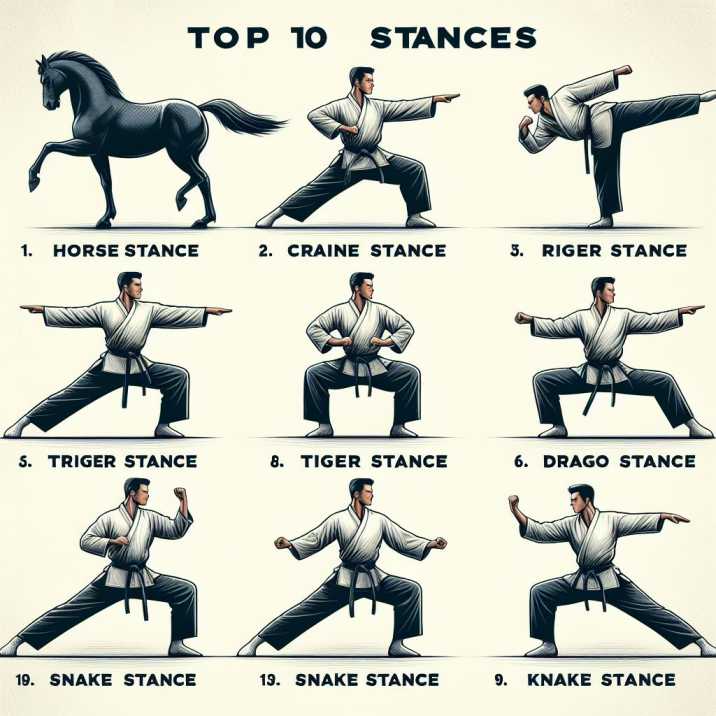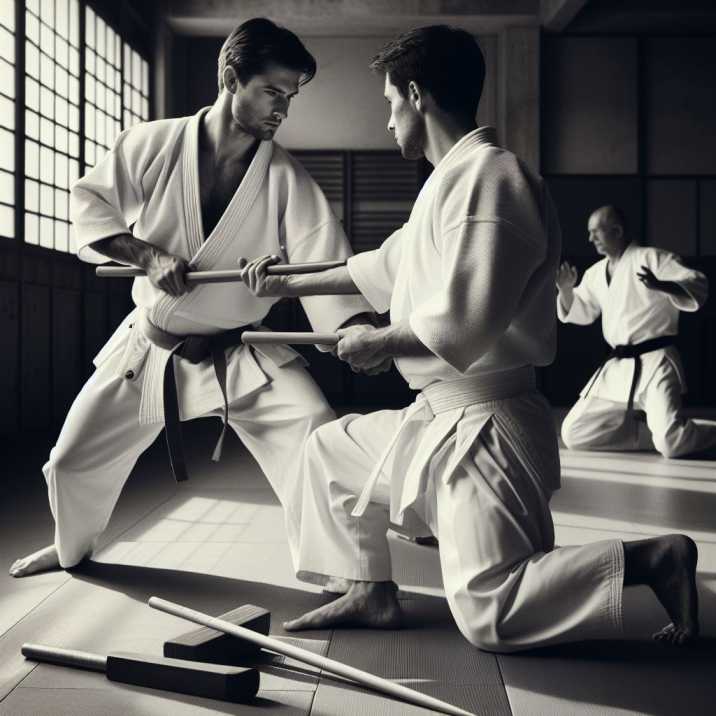Introduction:
Table of Contents
Martial arts have captivated people for centuries, originating from diverse cultures around the globe. These disciplines are not merely about combat; they embody a rich tapestry of traditions, philosophies, and techniques that promote physical prowess, mental fortitude, and spiritual growth. In this comprehensive guide, we’ll delve into the top 10 best martial arts that have garnered widespread acclaim among practitioners in the United States. Each martial art boasts its unique characteristics, offering a myriad of benefits ranging from self-defense mastery to physical fitness enhancement.

Top 10 Best Martial Arts:
1. Karate: The Way of the Empty Hand
Karate, which means “empty hand” in Japanese, originated in the Ryukyu Kingdom (present-day Okinawa, Japan). It is renowned for its emphasis on striking techniques, including punches, kicks, knee strikes, and elbow strikes. Karate practitioners, known as karateka, hone their skills through katas (pre-arranged forms) and kumite (sparring). The discipline instills values such as discipline, respect, and perseverance, making it a popular choice for practitioners of all ages.
- Training: Practitioners, called karateka, refine their skills through katas (pre-arranged forms) and kumite (sparring).
- Values: Karate instills discipline, respect, and perseverance, making it a holistic practice for personal development.
2. Taekwondo: The Art of Foot and Fist
Taekwondo, a Korean martial art, places a strong emphasis on kicking techniques, characterized by high and spinning kicks. It evolved from traditional Korean martial arts and gained international recognition for its inclusion in the Olympic Games. Taekwondo training involves a combination of poomsae (patterns), kyukpa (breaking techniques), and sparring. It emphasizes the five tenets of Taekwondo: courtesy, integrity, perseverance, self-control, and indomitable spirit.
- Training: Taekwondo training includes poomsae (patterns), kyukpa (breaking techniques), and sparring, focusing on physical and mental conditioning.
- Philosophy: The five tenets of Taekwondo – courtesy, integrity, perseverance, self-control, and indomitable spirit – guide practitioners in both martial arts and life.
3. Brazilian Jiu-Jitsu: The Gentle Art
Brazilian Jiu-Jitsu (BJJ) traces its roots to Japanese Jiu-Jitsu and Judo, with a focus on ground fighting and submission holds. Unlike other martial arts that rely on strength and athleticism, BJJ emphasizes leverage and technique, allowing smaller practitioners to overcome larger opponents. BJJ practitioners, known as grapplers, learn to control opponents using positions such as mount, guard, and side control, as well as apply joint locks and chokeholds.
- Approach: Unlike other martial arts, BJJ focuses on leverage and technique rather than strength, allowing smaller practitioners to overcome larger opponents.
- Techniques: Grapplers learn to control opponents using mount, guard, and side control positions, applying joint locks and chokeholds with precision.
4. Muay Thai: The Art of Eight Limbs
Muay Thai, also known as Thai boxing, is the national sport and cultural martial art of Thailand. It is distinguished by its use of fists, elbows, knees, and shins, earning it the moniker “the art of eight limbs.” Muay Thai training encompasses pad work, bag work, sparring, and clinch work, focusing on conditioning, technique, and mental toughness. The discipline is deeply ingrained in Thai culture, with rituals such as the wai kru (teacher’s respect) performed before bouts.
- Training: Muay Thai training encompasses various elements such as pad work, bag work, sparring, and clinch work, focusing on physical conditioning and mental toughness.
- Cultural Significance: Embedded in Thai culture, Muay Thai rituals like the wai kru demonstrate respect for tradition and heritage.
5. Judo: The Gentle Way
Judo, meaning “gentle way” in Japanese, was founded by Jigoro Kano in the late 19th century. It emphasizes the principle of maximum efficiency with minimal effort, using throws, takedowns, and pins to overcome opponents. Judo training includes randori (free practice), kata (forms), and competition, fostering physical fitness, mental focus, and mutual respect. The discipline’s core tenets are “mutual welfare and benefit,” reflecting its emphasis on personal development and harmony.
- Training: Judo training includes randori (free practice) and kata (forms), developing physical fitness, mental focus, and mutual respect.
- Philosophy: Core tenets like “mutual welfare and benefit” reflect Judo’s focus on personal growth and harmony.
6. Kung Fu: The Ancient Chinese Martial Arts
Kung Fu, also known as Wushu or Chinese martial arts, encompasses a diverse range of fighting styles developed over thousands of years in China. It is characterized by fluid, dynamic movements, and intricate techniques, with practitioners often training in forms (katas), sparring, and weapon techniques. Kung Fu emphasizes balance, coordination, and self-awareness, drawing inspiration from Chinese philosophy, mythology, and folklore.
- Styles and Variations: Kung Fu encompasses numerous styles, including Shaolin Kung Fu, Wing Chun, Tai Chi, and Wushu, each with its unique techniques and principles.
- Famous Kung Fu Masters: Legends such as Bruce Lee, Jet Li, and Jackie Chan have popularized Kung Fu through their movies and contributions to the martial arts world.
- Kung Fu Movies: The genre of Kung Fu cinema has inspired audiences worldwide with its epic battles, philosophical themes, and awe-inspiring choreography.
7. Krav Maga: The Practical Self-Defense System
Krav Maga, developed in Israel by Imi Lichtenfeld, is a practical self-defense system designed for real-life situations. It incorporates elements of boxing, wrestling, and street fighting, focusing on instinctive movements and aggressive counterattacks. Krav Maga training emphasizes situational awareness, defensive tactics, and de-escalation techniques, empowering practitioners to defend themselves effectively in various scenarios.
- Krav Maga Schools Worldwide: Krav Maga has spread globally, with schools and training centers offering classes for civilians, law enforcement personnel, and military units.
- Women’s Self-Defense Workshops: Many Krav Maga schools offer specialized workshops and courses tailored to women, focusing on practical self-defense techniques and strategies.
- Krav Maga Competitions: While Krav Maga is primarily a self-defense system, there are occasional competitions and events where practitioners can showcase their skills in controlled environments.
8. Aikido: The Way of Harmony
Aikido, founded by Morihei Ueshiba in the early 20th century, is a Japanese martial art that emphasizes harmony and non-violence. It utilizes joint locks, throws, and pins to redirect an opponent’s energy and neutralize attacks. Aikido practitioners, known as aikidoka, seek to blend with an attacker’s movements rather than oppose them, promoting a peaceful resolution to conflicts. The discipline’s philosophy encompasses the unity of mind, body, and spirit, fostering personal growth and self-awareness.
- Aikido Retreats and Seminars: Aikido practitioners often participate in retreats and seminars led by experienced instructors, providing opportunities for intensive training and philosophical discussions.
- Aikido in Popular Culture: Aikido’s graceful techniques and philosophical principles have been featured in movies, books, and television shows, contributing to its global popularity and recognition.
- Aikido Organizations: Various Aikido organizations and federations promote the art worldwide, organizing seminars, demonstrations, and events to foster camaraderie and skill development among practitioners.

9. Capoeira: The Dance of War
Capoeira is a Brazilian martial art that combines elements of dance, acrobatics, and music. It originated among African slaves in Brazil as a form of resistance and self-defense. Capoeira is characterized by its fluid, rhythmic movements, and dynamic kicks, performed in a roda (circle) accompanied by live music and singing. The discipline promotes agility, flexibility, and creativity, with practitioners engaging in playful sparring to the beat of the berimbau (musical instrument).
- Capoeira Festivals and Events: Throughout the year, Capoeira communities organize festivals, batizados (graduation ceremonies), and rodas open to practitioners of all levels, fostering a sense of community and celebration.
- Capoeira Schools Around the World: Capoeira has spread globally, with schools and academies established in countries across Europe, North America, and beyond, offering classes, workshops, and cultural exchanges.
- Capoeira in Popular Culture: Capoeira’s vibrant performances and cultural significance have been featured in movies, documentaries, and music videos, showcasing its rich heritage and artistic expression.
10. Mixed Martial Arts (MMA): The Evolution of Combat Sports
Mixed Martial Arts (MMA) is a full-contact combat sport that integrates techniques from various martial arts disciplines, including striking and grappling. It gained popularity in the early 1990s with the inception of the Ultimate Fighting Championship (UFC). MMA fighters, known as mixed martial artists, compete in a caged or roped arena, utilizing a combination of striking, clinch work, and ground fighting. The sport emphasizes adaptability and versatility, with fighters drawing from multiple martial arts to excel in competition.
- MMA Training Camps: Professional MMA fighters often train at specialized training camps, where they hone their skills under the guidance of experienced coaches and sparring partners.
- MMA Documentaries and Films: Documentaries and films exploring the world of MMA provide insights into the lives of fighters, the evolution of the sport, and the challenges they face both inside and outside the cage.
- MMA Community and Fanbase: MMA has a dedicated fanbase worldwide, with events regularly attracting large crowds and viewership, fostering a sense of camaraderie and excitement among enthusiasts.
Table Summarizing Key Information about Top 10 Best Martial Arts:
| Martial Art | Origin | Emphasis | Training Components |
|---|---|---|---|
| Karate | Ryukyu Kingdom (Okinawa, Japan) | Striking techniques such as punches, kicks | Katas (pre-arranged forms), Kumite (sparring) |
| Taekwondo | Korea | Kicking techniques, including high and spinning kicks | Poomsae (patterns), Kyukpa (breaking techniques), Sparring |
| Brazilian Jiu-Jitsu | Japan (traces roots), Brazil | Ground fighting, submission holds | Grappling, Joint locks, Chokeholds |
| Muay Thai | Thailand | Use of fists, elbows, knees, and shins | Pad work, Bag work, Sparring, Clinch work |
| Judo | Japan | Throws, takedowns, pins | Randori (free practice), Kata (forms), Competition |
| Kung Fu | China | Fluid, dynamic movements, and intricate techniques | Forms (katas), Sparring, Weapon techniques |
| Aikido | Japan | Joint locks, throws, and pins | Randori (free practice), Kata (forms) |
| Krav Maga | Israel | Self-defense techniques, counterattacks | Strikes, Joint manipulation, Ground fighting |
| Capoeira | Brazil | Martial art combined with dance and acrobatics | Ginga (basic movement), Attacks, Defenses |
| Kickboxing | Japan and America | Strikes using fists and legs, often in combination | Bag work, Pad work, Sparring, Conditioning |
This table offers a brief overview of each martial art’s origin, primary emphasis, and typical training components.
Conclusion:
In conclusion, martial arts offer a wealth of benefits for individuals seeking self-improvement, physical fitness, and personal growth. Whether you’re drawn to the striking techniques of Karate, the grappling prowess of Brazilian Jiu-Jitsu, or the dynamic kicks of Taekwondo, there’s a martial art suited to your interests and goals. By embracing the discipline, dedication, and perseverance required to master a martial art, you embark on a transformative journey of self-discovery and empowerment.
FAQs:
- Which martial art is best for self-defense?
- Krav Maga is highly effective for self-defense due to its focus on practical techniques for real-life situations.
- Which martial art is best for fitness?
- Muay Thai and Brazilian Jiu-Jitsu are excellent for fitness, as they provide intense workouts while teaching valuable self-defense skills.
- Can anyone learn martial arts?
- Yes, martial arts are accessible to people of all ages, genders, and fitness levels. It’s never too late to start training!
- Do I need special equipment to practice martial arts?
- While some martial arts require specific gear such as gloves or uniforms, many can be practiced with minimal equipment.
- How long does it take to become proficient in a martial art?
- The time it takes to become proficient varies depending on factors such as dedication, consistency, and the complexity of the martial art. With regular practice and proper instruction, progress can be made at any pace.


